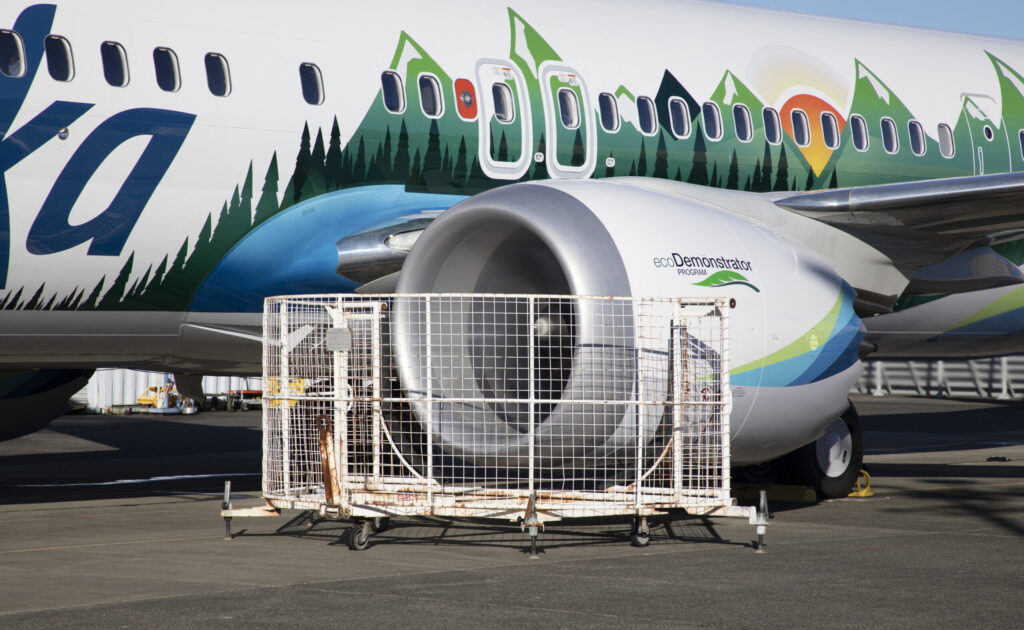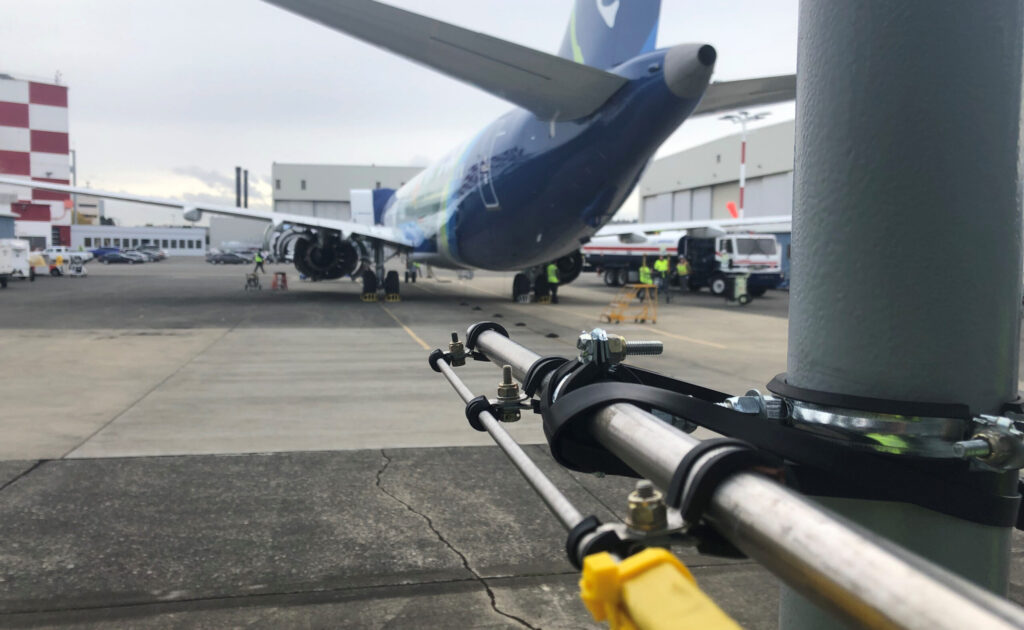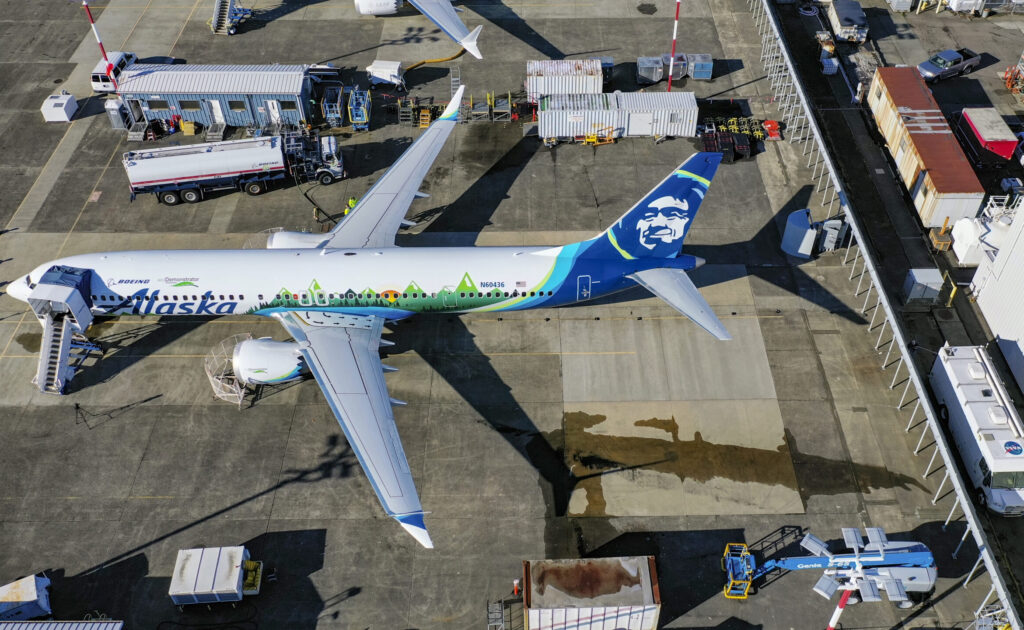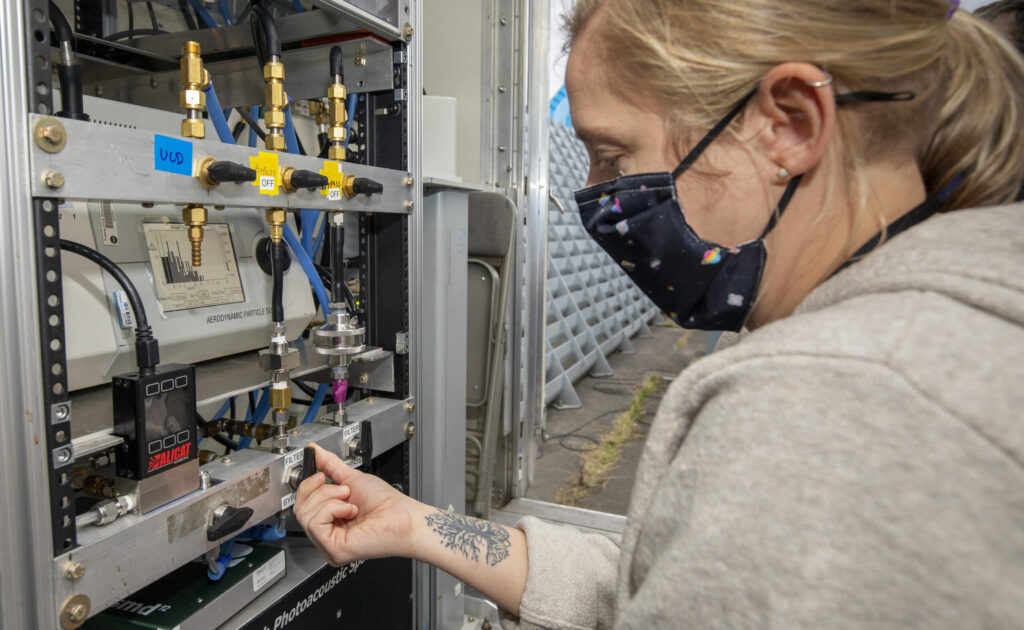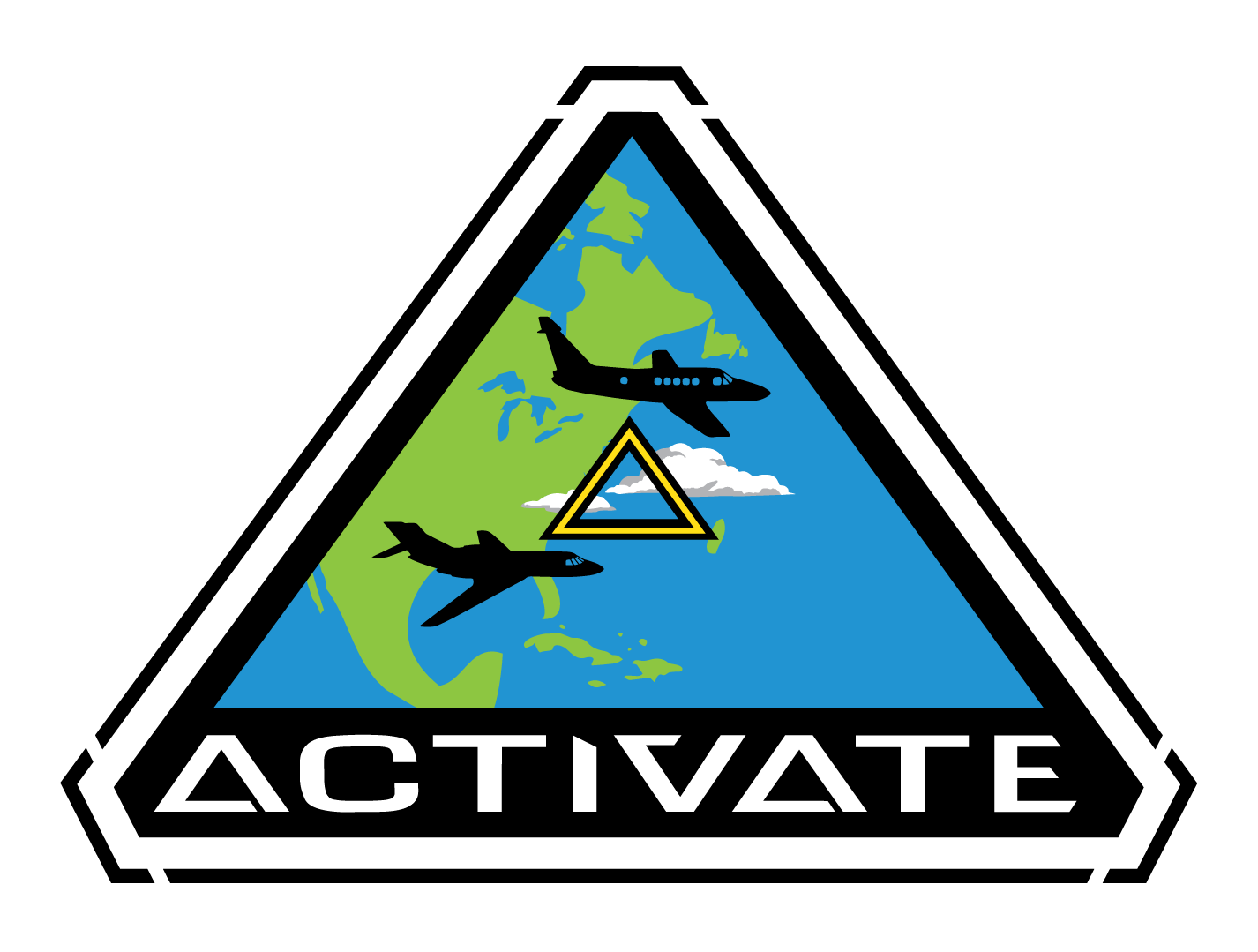2021 Boeing ecoDemonstrator Emissions Ground Test
Cite as: Boeing ecoDemonstrator Science and Engineering Team. (2021), 2021 Boeing ecoDemonstrator Emissions Ground Test Dataset, https://doi.org/10.57700/1f7s-tn05
Participants: Click here for complete list
Keywords: sustainable aviation fuel, biofuel, aerosols, trace gases, 737-MAX, LEAP-1B engines, ecoDemonstrator, ground test
Dates: 18 October 2021 – 31 October 2021
Location: Boeing Field, Seattle, Washington, USA
DATA DOWNLOAD |
|---|
| COMING SOON |
PROJECT LOGO |
|---|
LICENSE |
|---|
Data are licensed under a CC0 1.0 Universal (CC0 1.0) Public Domain Dedication license pursuant to the U.S. Federal Open Data Policy. |
Sponsors:
- Boeing ecoDemonstrator Program
- NASA Aeronautics Research Mission Directorate (ARMD) Advanced Air Transport Technology (AATT) Project within the Advanced Air Vehicles Program (AAVP)
- NASA Science Mission Directorate (SMD) Earth Science Division
- Federal Aviation Administration Ascent Program
Project Summary:
A team of scientists and engineers from Boeing, Aerodyne Research, and the National Aeronautics and Space Administration measured the engine particle and trace gas emissions from the 2021 Boeing ecoDemonstrator aircraft. Instrument set up, calibration, and testing took place at Boeing Field in Seattle, Washington, USA, from October 18-31, 2021.
This year’s ecoDemonstrator aircraft is an Alaska Airlines 737-MAX 9 that is equipped with CFM International LEAP-1B engines that are expected to have some of the lowest particle emissions of any aircraft engines currently in service. The goals of the project are to quantify these engine emissions while burning 100% Sustainable Aviation Fuel (SAF) for the first time and compare the results to those obtained for conventional, petroleum-based Jet A fuel and blends of the SAF with Jet A. Studying multiple fuels with the same LEAP-1B engine allows us to differentiate the emissions reductions resulting from the LEAP’s advanced engine technology from those resulting from the advanced jet fuel chemistry.
This research is important because particle and gas emissions from aircraft engines impact the air quality of communities near airports and contribute to climate warming by forming contrail cirrus clouds that disrupt Earth’s radiation balance. The results from this ground test cover the full range of engine powers from idle conditions to cruise and takeoff thrusts and inform efforts to understand and mitigate the environmental impact of aviation. In addition, demonstrating the capability to burn 100% SAF is important for meeting the aviation sector’s targets for future carbon-neutral growth, while also showing the co-beneficial particle reductions associated with these fuels. The 2021 Boeing ecoDemonstrator aircraft is the ideal testbed for quantitatively demonstrating the emissions reductions resulting from a combination of advanced engine and fuel technologies that will be necessary to meet the aviation environmental challenges of the coming decades.
By the Numbers:
- Boeing 737-MAX 9 Aircraft With CFM International LEAP-1B Engines
- 4 Investigated Jet Fuels:
- 100% Sustainable Aviation Fuel (SAF)
- 50% SAF – 50% Jet A Blend
- 30% SAF – 70% Jet A Blend
- 100% Conventional, Petroleum-Based Jet A Fuel
- 8 Investigated Engine Thrust Settings (Set By Engine Fan Speed, N1):
- Nominal N1s ~ 20%, 35%, 50%, 60%, 67%, 75%, 85%, 90%
- 32 Meters of Distance Between the LEAP-1B Engines and the Sampling Probe Inlet
- 4 Meters of Transport Tubing Between the Inlet and the NASA Mobile Laboratory
- > 560 Minutes Of ‘On Condition’ Emissions Sampling Time
- 3 Bags of Peanut M&Ms Consumed By the NASA Test Team
Emissions Measurements:
| Geophysical Measurement Parameter | Analytical Instruments |
|---|---|
| Non-Volatile (350°C) Particle Number Concentration (multiple lower diameter cutoffs including 3, 7, 8, 16, 32, and 64 nm) | – Nucleation-Mode Aerosol Size Spectrometer (NMASS) – BMI Mixing Condensation Particle Counter (mCPC 1720) |
| Particle Number Concentration (multiple lower diameter cutoffs including 2.5, 3, 7, 8, 16, 32, and 64 nm) | – Nucleation-Mode Aerosol Size Spectrometer (NMASS) – BMI Mixing Condensation Particle Counter (mCPC 1720) – TSI Ultrafine Condensation Particle Counter (CPC3756) |
| Non-Volatile (350°C) Particle Size Distribution (3 nm – 300 nm diameters) | – Nucleation-Mode Aerosol Size Spectrometer (NMASS) – TSI Scanning Mobility Particle Sizer (SMPS) |
| Particle Size Distribution (3 nm – 20,000 nm diameters) | – Nucleation-Mode Aerosol Size Spectrometer (NMASS) – TSI Scanning Mobility Particle Sizer (SMPS) – TSI Engine Exhaust Particle Sizer (EEPS 3090) – TSI Aerodynamic Particle Sizer (APS 3321) |
| Particle Light Absorption, Scattering, and Extinction Coefficients (Used to Compute Black Carbon Mass) | – Aerodyne Cavity Attenuated Phase Shift Monitor (CAPS) – Aerodyne CAPS Single Scatter Albedo Monitor (CAPS-SSA) – TSI Nephelometer – BMI Tri-Color Absorption Photometer (TAP) – ThermoScientific Multi-Angle Absorption Photometer (MAAP) – AVL Micro Soot Sensor (MSS+) |
| Particle Chemical Composition | – Aerodyne Soot Particle High-Resolution, Particle Time-of-Flight,Aerosol Mass Spectrometer (SP-HR-ToF-AMS) – EC/OC Quartz Filters |
| Trace Gas Mixing Ratios | – Picarro In-Flight Gas Concentration Analyzer (CO2, CO, CH4, and H2O) – Licor 7000 CO2 Analyzer – LGR NO2 Monitor + Ozone Add Flow (NOx) – LGR NO2 Monitor (NO2) |
Engine Operating and Environmental Condition Parameters:
| Parameter Type | Data Variables |
|---|---|
| Engine Operating Conditions for the test engine (Left, #1) | – Fan Speed, N1 (% of maximum) – Core Speed, N2 (% of maximum) – Fuel Flow Rate, (kg/s) |
| Environmental and Meteorological Conditions (Meteorological station located near the nose of the aircraft) | – Latitude (degrees) – Longitude (degrees) – Heading (degrees) – Ambient Air Temperature (°C) – Ambient Air Pressure (hPa) – Ambient Air Relative Humidity (%) – Ambient Air Dewpoint Temperature (°C) – Wind Speed (knots) – Wind Direction (degrees) – Crosswind and Headwind Wind Speed – Components (knots) – Solar Radiation (W/m2) |
| ecoDemonstrator Trace Gas Mixing Ratios from a Picarro In-Flight Gas Concentration Analyzer (Inlet on the starboard side of the aircraft, forward of the engine) | – Ambient Carbon Dioxide Mixing Ratio (ppmv) – Ambient Carbon Monoxide Mixing Ratio (ppmv) – Ambient Methane Mixing Ratio (ppmv) – Ambient Water Vapor Mixing Ratio (%) |
Project Participants:
Project Participants:
Richard H. Moore, Matthew D. Brown, Elizabeth B. Wiggins, Edward L. Winstead, Luke D. Ziemba, Joshua DiGangi, Michael L. Shook, John Barrick, Yonghoon Choi, Ewan C. Crosbie, Glenn Diskin, Francesca Gallo, Carolyn Jordan, Claire E. Robinson, Kevin J. Sanchez, Kenneth L. Thornhill, and Richard Wahls
NASA Langley Research Center, Hampton, Virginia, USA
Steven L. Baughcum, William Griffin, Addison Salzman, Laura B. Smit, Megan Dolan, Benjamin Wasilowski, Rachel Wittrock, Michael Johnson, Cory Moderhak, Jeffrey McNew, Eugene Lardizabal, Nathan Quick, Dale Smith, Craig Wilsey, Paul Weatherman, Elisa Alfstad-Hahn, and Douglas P. Christensen
The Boeing Company, Seattle, Washington, USA
Jennifer L. Klettlinger, Francisco Guzman, Derek Podboy, and Jeff Moder
NASA Glenn Research Center, Cleveland, Ohio, USA
Richard C. Miake-Lye, Benjamin Nault, Edward Fortner and Andrew Freedman
Aerodyne Research, Billerica, Massachusetts, USA

